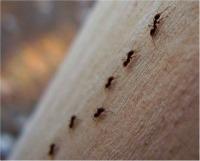Information for Child Care Providers about Pesticides/Integrated Pest Management

Exposure to pests such as cockroaches, rodents, ants, and stinging insects in childcare centers may place children at risk for disease, asthma attacks, bites, and stings. Improper use of pesticides can also place children at risk. A recent study of pesticide use in child care centers revealed that 75% of centers reported at least one pesticide application in the last year. Several factors increase both children's exposures and their vulnerability to these exposures compared to adults. Children spend more time on the floor, where residues can transfer to skin and be absorbed.
Young children also frequently place their hands and objects in their mouths, resulting in non-dietary ingestion of pesticides. Children are less developed immunologically, physiologically, and neurologically, and therefore may be more susceptible to the adverse effects of chemicals and toxins. There is increasing evidence of adverse effects of pesticides on young children, particularly on neurodevelopment. The following links provide information about the health effects associated with exposure to pests and pesticides and the steps that can be taken to use integrated pest management strategies in childcare facilities.
Resources
- Keep Pests Out of Your Child Care Center (English Version)(2 pp, 323 KB, About PDF) Exit
Keep Pests Out of Your Child Care Center (Spanish Version)(2 pp, 196 KB, About PDF) Exit - Child Care Pest Information Series, from the California Department of Pesticide Regulation
- Mice and Rats: English Version(2 pp, 321 KB, About PDF) , Mice and Rats: Spanish Version(2 pp, 323 KB, About PDF) Exit
- Argentine Ants: English Version(2 pp, 239 KB, About PDF) , Argentine Ants: Spanish Version(2 pp, 196 KB, About PDF) Exit
- Cockroaches: English Version(2 pp, 313 KB, About PDF) , Cockroaches: Spanish Version(2 pp, 212 KB, About PDF) Exit
- Bed Bugs: English Version(2 pp, 351 KB, About PDF) , Bed Bugs: Spanish Version(2 pp, 250 KB, About PDF) Exit
- Integrated Pest Management: A Curriculum for Early Child Care and Education Programs(13 pp, 2.1 MB, About PDF) Exit
- Integrated Pest Management (IPM) in Child Care (also available in Spanish)
- IPM for Child Care and Early Learning Environments Exit
- IPM in Child Care Centers Exit
- Child Day Care Facilities IPM Exit
- The School IPM Listserv Exit
- Parent/Guardian Permission to Apply Insect Repellant to Child(1 pp, 86 KB, About PDF) Exit
- What to Do About Bugs, Weeds, and Other Pests: Child Care Pest Information Series Exit
